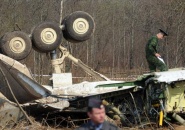Recommended:
- The Smolensk Conferences. A Preliminary Summary and Conclusion
- NEW STUDY: Putin's Russian inquiry into the Polish Air Force One crash in Smolensk
- 15 SIMPLE FACTS THE WORLD SHOULD KNOW
- Smolensk Reader's Digest. 23 pages, all the facts.
- Polish Military Intelligence was warned of a possible terrorist threat against one of the EU Member States' aircraft.
- Story behind the "1:24"
Prof. Jorgensen initially considered the official version presented by the Russian Interstate Aviation Committee and the Polish governmental team to be the most probable course of events. However, after months of research and calculations, he realised that the two governmental committees presented a misleading picture and set of circumstances into the causes and course of events of the disaster.
Professor Glenn Jorgensen from the Technical University of Denmark was a recent guest at a meeting of the independent parliamentary group, led by MP Antoni Macierewicz, set up for the investigation of the Polish presidential plane crash in Smolensk.
Jorgensen initially considered the official version of events presented by the MAK (Russian Interstate Aviation Committee - IAC) and the Polish governmental team to be the most probable course of events, however, after months of research and calculations it turned out that the two (Russian and Polish) governmental committees presented a misleading picture and set of circumstances into causes and course of events of the disaster.
- First, I wanted to prove that the official version of the crash was correct, but when I started to analyze the data, I found that I was wrong and that, in-line with the official version specified, this disaster could not have happened - said Jorgensen, explaining his reason for taking a closer look into the crash.
According to the Danish expert, the plane by only losing the tip of its wing, as - "stipulated by the Russian IAC and the Polish governmental reports, the airplane would have not hit the ground, but would have been at that moment at an altitude of almost 40 meters above the place of impact, and would have been able to fly away."
- By losing just a piece of the wing, the plane would have only lost around 5 percent of its lift force (aerodynamic force). The plane would have found itself at about 30 meters to the north and would have been at a height of 40 m above the given place of impact. - Jorgensen said.
According to him, a hypothesis based on the loss of additional wing fragments would coincide with what was found among the wreckage, where - as he noted - "pieces of the left wing were lying near the street, located to the place of impact."
- Official versions do not explain the tilt angle of the aircraft at the time of impact with the ground, the ground traces left by the left wing and the tail of the aircraft and the strange behavior of the elevator controls. This can all be explained, if we assume that the plane had lost an additional piece of its wing - according to Jorgensen
According to Jorgensen, "something happened to the elevator control" and "one of the hypotheses may be that by losing the wing some additional pieces/fragments broke away, hitting the elevator."
Moreover - according to Jorgensen - "the altitude of the aircraft at the location of the famous birch tree could not have been lower than 11 meters."
Translated from source: niezależna.pl





